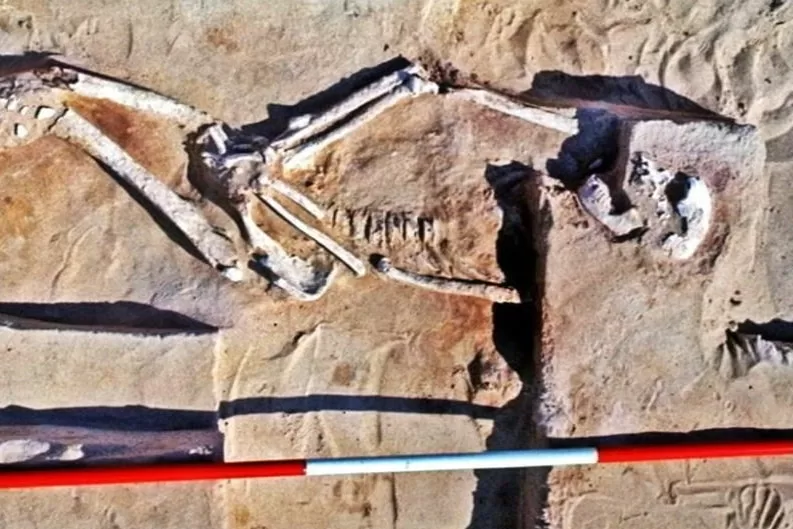Fifty years ago, Australia’s history was rewritten by a chance discovery in Far West New South Wales.
Geologist Jim Bowler was on a journey to explore the geological legacy of climatic change in ice age landscapes at what is now Lake Mungo when he saw something shining white in the sand.
He brushed the sand away and saw it was the dome of a human skull exposed as wind eroded ancient layers of soil.
The discovery would alter the global understanding of our species and rewrite the history of the Australian continent.
Now 94, Mr Bowler returned to the site last month for what he says could be his last visit.
“I’m returning here after a little bit more than 50 years to celebrate not just the details of what I found here, but to celebrate the lives of those ancient people who lived here and who provided the foundation for the World Heritage Area,” he says.
But the legacy of the discovery of Mungo Man is complicated.
“I am a geologist who has intruded into this landscape at great cost to myself,” Mr Bowler says.
“I have disturbed the lives of many people in so doing.”
Rewriting Australian history
The date was February 1974 and Mr Bowler was riding his motorbike around Lake Mungo mapping the shorelines of the ancient lake bed.
The cranium, when Mr Bowler excavated it together with anthropologist Alan Thorne, revealed the almost complete skeleton of an adult male.
The body was dated at about 42,000 years old — about 39,000 years before the pyramids were built in ancient Egypt.
The discovery of Mungo Man added new detail to the society Aboriginal people had created on the Australian continent all those years ago.
The position of Mungo Man’s body and the decision to either coat or sprinkle the body with ochre indicated the people who buried him held traditions and potentially religious beliefs, Mr Bowler says.
“These people were highly sophisticated 40,000 years ago, nobody had ever thought of Indigenous Australia in those terms,” he says.
“There’s no ochre within well over 100 kilometres … that ochre had to be prepared in advance, brought in, traded maybe.
“Quite a detailed ritual involved in that exercise, bringing the stuff in and preparing it and anointing the body.
“It’s the sort of thing that goes on in a requiem in any cathedral.
“Here it was on the cathedral shores of Lake Mungo, 40,000 years ago.”
‘Came back for a reason’
Wamba Wamba and Mutthi Mutthi man Jason Kelly says the story of Mungo Man is a story of transformation — not just of Australian history, but of Aboriginal and non-Aboriginal relations.
Initially, Aboriginal people, including Mr Kelly’s grandmother, Mutthi Mutthi woman Alice Kelly, saw scientists like Mr Bowler as continuing a colonial legacy of “grave robbing”.
But over time Ms Kelly and Mr Bowler developed what Mr Kelly described as “a meaningful relationship and got to know each other, and actually became great friends in the end”.
“My nan and … the elders that followed, always talked about how Mungo Man and Mungo Lady came back for a reason,” Mr Kelly says.
“They came back for the future and the future generations to tell the story about the history of us.”
The remains of Mungo Lady, discovered in 1968, were returned by researchers to Lake Mungo in 1992.
Mungo Man was returned to his home in 2017, and the Australian National University issued an apology to traditional owners for the hurt his original removal had caused.
In 2022, the remains of Mungo Man and Mungo Lady were removed from storage and reburied secretly in unknown graves, despite a last-minute legal challenge by First Nations people from the Paakantji (Barkindji) and Mutthi Mutthi tribes.
An independent report commissioned by the NSW government into the decision to move the remains has not been publicly released.
A spokesperson from the NSW Department of Climate Change, Energy, the Environment and Water (DCCEEW) said the independent report was legally privileged and also contained issues of high cultural sensitivity.
“Questions on the assessment of the Commonwealth Aboriginal and Torres Strait Islander Heritage Protection Act 1984 (ATSIHP Act) application should be directed to the federal Department of Climate Change, Environment, Energy and Water,” they said.
“The department can confirm it is satisfied that the remains of Mungo Man and Mungo Lady were buried in accordance with the conditions of approval stipulated by the Commonwealth in the approval given under the EPBC (Environment Protection and Biodiversity Conservation) Act.
“The reburial took place after extensive community consultation and was consistent with a resolution made by the elected Willandra Lakes Region World Heritage Aboriginal Advisory Group to rebury the ancestral remains.”
‘Always known it was a special place’
The revelation that Aboriginal people had been in Australia for more than 40,000 years was not news to Aboriginal people.
Mutthi Mutthi and Paakantji (Barkindji) woman and PhD candidate Sophia Pearce says Lake Mungo is part of her people’s creation stories.
“The place that we’ve always known has been a special place in terms of our creation stories and then Jim, of course, comes along,” Ms Pearce says.
“I think that it was more that Mungo Man was revealing himself to the world. And that Jim happened to be there. And their meeting had come about because of that.”
The discovery led to the Willandra Lakes system becoming a World Heritage area in 1981.
“It puts us on the map in terms of Lake Mungo, and the history associated with Mungo,” Ms Pearce says.
“Along with World Heritage came a whole lot of restrictions, but they were, for us, protecting our culture in a way that, as grassroots people, we couldn’t do ourselves.”
The UNESCO-listed site, which is managed by the National Parks and Wildlife Service, is made up of 30 per cent National Park and 70 per cent pastoral leases.
Stories from farms and country towns across Australia, delivered each Friday.
